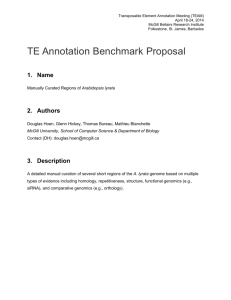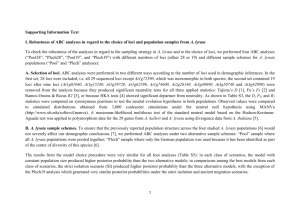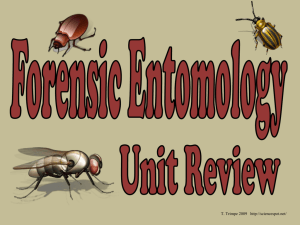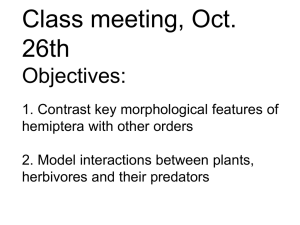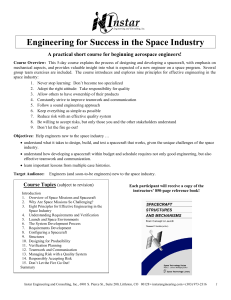Seljak Malenovsky 2014 Bactericera lyrata immatures
advertisement
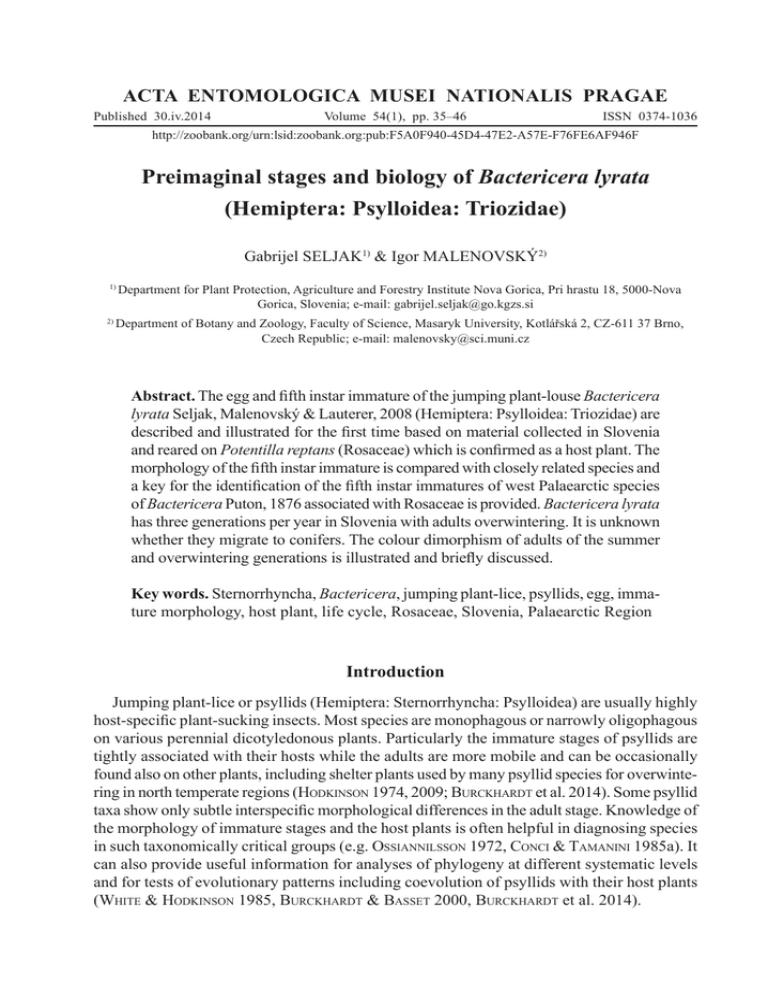
ACTA ENTOMOLOGICA MUSEI NATIONALIS PRAGAE Published 30.iv.2014 Volume 54(1), pp. 35–46 ISSN 0374-1036 http://zoobank.org/urn:lsid:zoobank.org:pub:F5A0F940-45D4-47E2-A57E-F76FE6AF946F Preimaginal stages and biology of Bactericera lyrata (Hemiptera: Psylloidea: Triozidae) Gabrijel SELJAK1) & Igor MALENOVSKÝ2) 1) 2) Department for Plant Protection, Agriculture and Forestry Institute Nova Gorica, Pri hrastu 18, 5000-Nova Gorica, Slovenia; e-mail: gabrijel.seljak@go.kgzs.si Department of Botany and Zoology, Faculty of Science, Masaryk University, KotláĜská 2, CZ-611 37 Brno, Czech Republic; e-mail: malenovsky@sci.muni.cz Abstract. The egg and ¿fth instar immature of the jumping plant-louse Bactericera lyrata Seljak, Malenovský & Lauterer, 2008 (Hemiptera: Psylloidea: Triozidae) are described and illustrated for the ¿rst time based on material collected in Slovenia and reared on Potentilla reptans (Rosaceae) which is con¿rmed as a host plant. The morphology of the ¿fth instar immature is compared with closely related species and a key for the identi¿cation of the ¿fth instar immatures of west Palaearctic species of Bactericera Puton, 1876 associated with Rosaceae is provided. Bactericera lyrata has three generations per year in Slovenia with adults overwintering. It is unknown whether they migrate to conifers. The colour dimorphism of adults of the summer and overwintering generations is illustrated and brieÀy discussed. Key words. Sternorrhyncha, Bactericera, jumping plant-lice, psyllids, egg, immature morphology, host plant, life cycle, Rosaceae, Slovenia, Palaearctic Region Introduction Jumping plant-lice or psyllids (Hemiptera: Sternorrhyncha: Psylloidea) are usually highly host-speci¿c plant-sucking insects. Most species are monophagous or narrowly oligophagous on various perennial dicotyledonous plants. Particularly the immature stages of psyllids are tightly associated with their hosts while the adults are more mobile and can be occasionally found also on other plants, including shelter plants used by many psyllid species for overwintering in north temperate regions (HODKINSON 1974, 2009; BURCKHARDT et al. 2014). Some psyllid taxa show only subtle interspeci¿c morphological differences in the adult stage. Knowledge of the morphology of immature stages and the host plants is often helpful in diagnosing species in such taxonomically critical groups (e.g. OSSIANNILSSON 1972, CONCI & TAMANINI 1985a). It can also provide useful information for analyses of phylogeny at different systematic levels and for tests of evolutionary patterns including coevolution of psyllids with their host plants (WHITE & HODKINSON 1985, BURCKHARDT & BASSET 2000, BURCKHARDT et al. 2014). 36 SELJAK & MALENOVSKY: Preimaginal stages and biology of Bactericera lyrata (Triozidae) The genus Bactericera Puton, 1876 is one of the taxonomically problematic groups where closely related species are often morphologically similar. It currently includes 160 species distributed predominantly in the Holarctic Region (BURCKHARDT & LAUTERER 1997, LI 2011, OUVRARD 2013). A few of them are polyphagous and major (vectors of phytopathogenic bacteria) or minor pests on cultivated crops, such as Bactericera cockerelli (Šulc, 1909) on potato, tomato and capsicum (BURCKHARDT 1995, MUNYANEZA et al. 2007, BUCHMAN et al. 2011, ALVARADO et al. 2012), B. nigricornis (Foerster, 1848) on various vegetables (HODKINSON 1981), B. tremblayi (Wagner, 1961) on onion and leek (TREMBLAY 1965a,b; OUVRARD & BURCKHARDT 2012), and B. trigonica Hodkinson, 1981 on carrot (HODKINSON 1981, BURCKHARDT & FREULER 2000, WEINTRAUB & BEANLAND 2006). However, many Bactericera species are associated with the families Salicaceae, Rosaceae and Asteraceae (BURCKHARDT & LAUTERER 1997). One of the presumably Rosaceae-feeding species has been Bactericera lyrata Seljak, Malenovský & Lauterer, 2008, recently described from Slovenia (SELJAK et al. 2008) and subsequently reported from the Czech Republic and Hungary (MALENOVSKÝ & LAUTERER 2012). The original description was based on adult morphology. SELJAK et al. (2008) suggested a close relationship of B. lyrata to a small group of Palaearctic Bactericera species associated with Rosaceae and mentioned Potentilla reptans and Sanguisorba of¿cinalis as possible hosts that occurred on the sites where adults were collected. A small number of specimens available at the time of the description and particularly the absence of immature stages, however, did not allow to identify the host plant. Here we provide more details on the biology of B. lyrata: based on rearing we con¿rm Potentilla reptans as its host plant, describe the egg and ¿fth instar immature for the ¿rst time, compare them with related species, and discuss the life cycle. Material and methods In mid-September 2012 a series of adult specimens of B. lyrata were caught by G. Seljak in an abandoned ¿eld in western Slovenia near the village of Vogrsko in the Vipava Valley (the type locality of B. lyrata: SELJAK et al. 2008; Fig. 5). The specimens were reddish-coloured showing characteristics of a summer generation (Figs 1, 2). Among the plants growing on the site, Potentilla reptans was the most abundant (Fig. 11). As this plant species was suspected to be a potential host plant, more than 200 leaves of P. reptans were examined in detail on the site in order to ¿nd any preimaginal stages that might belong to B. lyrata; this search, however, was not successful. Therefore, a few plants of P. reptans from another place where no specimens of B. lyrata could be collected were planted in a pot and put in an insect cage. The insect cage was kept outdoors but protected from direct rain. Four adult females and two males of B. lyrata from Vogrsko were released in this cage to test if they accept P. reptans as a food plant. Within 30 minutes all specimens moved onto the leaves of P. reptans. As they were then staying at exactly the same places on the leaves for several hours they probably started to feed. On September 29 leaves in the cage were checked. Two females and one male were still alive and lots of eggs were scattered over both sides of the leaves (Fig. 10), being Acta Entomologica Musei Nationalis Pragae, 54(1), 2014 37 more numerous on the upper side. First instar immatures (Fig. 9) hatched in the ¿rst days of October and moved onto the lower leaf surface. The ¿rst three instars were not conserved for morphological studies to make sure that there was enough material for the development of stages four and ¿ve. Two specimens of the fourth and 15 specimens of the ¿fth instar were later carefully collected from the leaves and put into 70% ethanol. The rest of the immatures were reared to the adult stage. In 2013, the rearing procedure was repeated in the same way as in the previous year with adults collected at the same locality on July 13. As all adults were light-coloured, it was supposed that they belonged to the ¿rst summer generation. The cage was periodically checked for developmental stages. At the very beginning of October, when the ¿rst adults of the next generation (all light-coloured) appeared, two ¿fth instar immatures were collected for slide preparation. Adults and other immatures were left in the cage for further observations. On December 8, when the ¿rst overwintering adults (1 and 2 ) appeared, further rearing was stopped because the plants of Potentila reptans were almost completely destroyed by co-occurring aphids and mites. All remaining immatures on the leaves were preserved in 70% ethanol for subsequent slide mounting. Permanent slides from this material were prepared according to the slightly modi¿ed procedure by HODKINSON & WHITE (1979) and deposited in the insect collection of the Agriculture and Forestry Institute in Nova Gorica, Slovenia (ANGS). The following numbers of specimens were slide-mounted: 15 ¿fth instar immatures, 16 fourth instar immatures, 4 second instar immatures and 2 ¿rst instar immatures, all reared on Potentilla reptans by G. Seljak. For morphological comparisons, several slide-mounted specimens of ¿fth instar immatures from the collections of ANGS and the Moravian Museum, Brno, Czech Republic (MMBC) were examined for the following species: Bactericera acutipennis (Zetterstedt, 1828) (6 immatures, Czech Republic, western Moravia, Radenice, on Comarum palustre, 18.ix.1981, P. Lauterer leg.; 7 immatures, Czech Republic, western Moravia, Budeþ near Žćár nad Sázavou, reared on Comarum palustre, 18.vii.1980, P. Lauterer leg.; all MMBC); B. femoralis (Foerster, 1848) (3 immatures, Czech Republic, western Moravia, Prosetín-ýtyĜi Dvory, on Alchemilla sp., 28.viii.1964, P. Lauterer leg., MMBC), B. modesta (Foerster, 1848) (5 immatures, Slovenia, Nova Gorica, 9.x.2011, on Sanguisorba minor, G. Seljak leg., ANGS; 1 immature, Czech Republic, southern Moravia, Mikulov, Svatá hora Hill, reared on Sanguisorba minor, 11.vii.1970, P. Lauterer leg.), and B. reuteri (Šulc, 1913) (5 immatures, Czech Republic, southern Moravia, Velké NČmþice, Brodaþ Nature Reserve, 4.x.1962, on Potentilla anserina, P. Lauterer leg., MMBC, ANGS). The slide-mounted immatures were examined under a compound microscope (Nikon Eclipse Ni-U or Olympus BX-41) and imaged with an attached digital camera (Nikon DS-U3, Olympus 5060WZ). Measurements and counts were performed in the Nikon NIS Elements Documentation or the QuickPHOTO CAMERA 2.3 software. In addition, the examined material was also compared with the descriptions and drawings of the ¿fth instar immatures of Bactericera spp. in OSSIANNILSSON (1992) and BURCKHARDT & LAUTERER (1997). The morphological terminology follows WHITE & HODKINSON (1982) and OSSIANNILSSON (1992). The nomenclature of host plants is based on KURTTO (2009). 38 SELJAK & MALENOVSKY: Preimaginal stages and biology of Bactericera lyrata (Triozidae) Results Bactericera lyrata Seljak, Malenovský & Lauterer, 2008 (Figs 1–4, 6–10, 12) Bactericera lyrata Seljak et al., 2008: 530. The following sections complement the original description by SELJAK et al. (2008) by providing details about the coloration of the adults, the morphology of the ¿fth instar immature, egg, the host plant, and the life cycle. Adult. Coloration. Seasonally dimorphic. General body colour of specimens of the long day (summer) generation(s) almost uniformly reddish to orange brown with dark brown transversal bands on abdominal tergites. Males usually darker than females, red-brownish (Figs 1, 2). Forewings transparent. Short day specimens (late autumn, overwintering generation) markedly dark: males with thoracic dorsum evenly brownish black (Fig. 3; paler longitudinal stripes only visible in fresh specimens, disappearing later with hardening of cuticle); females dark brown to almost black with more or less distinct paler longitudinal stripes on thoracic dorsum (Fig. 4); forewing membrane light straw-yellowish in mature specimens of both sexes. Fifth instar immature (Figs 6, 12). Coloration. Short day immatures (autumn generation) dirty yellowish with diffuse dark brown markings on thorax and abdomen; brown markings concentrated on thorax along midline, in an obtuse V-shaped streak on mesothorax, a less apparent streak on metathorax, and patches on tips of fore- and hindwing-pads; abdomen with diffuse radial brown markings near margins of caudal plate (margins and central area of caudal plate lighter). Apices of tibiae, tarsi and antennae dark brown. Long day (summer) immatures are generally lighter with weakly or hardly pronounced brown markings. Structure. Body broadly Àattened, elliptic ovoid, anterior head and posterior caudal plate margins broadly rounded. Dorsal cuticle densely covered with ¿ne tubercles, caudal plate radially sculptured. Body margin completely bordered with sectasetae present in following numbers: head 58–69; forewing-pad 86–100; hindwing-pad 12–18; abdomen 170–215; poles of all sectasetae truncate, cylindrical, with almost perfectly parallel edges. Head and abdominal sectasetae densely arranged with interspaces of about 0.15 to 0.30 poles width. Forewing-pad sectasetae markedly shorter and more sparsely arranged with interspaces of about 0.5 to 1.1 poles width. Sectasetae completely absent from dorsum. Posterior eye margin with a small lobe lacking sectasetae. Antenna short, three-segmented, apical segment (Àagellum) narrowed in middle, indistinctly subdivided, with four rhinaria; terminal setae unequal in length, one truncated at tip, the other seta tapered and almost twice as long as the truncate one. Humeral lobes of forewing-pads large, distinctly surpassing anterior eye margin. Tarsal arolium relatively large (larger than claws), broadly triangular (trapezoidal). Anus situated ventrally, outer circumanal pore ring with one single row of densely arranged elliptic pores. Measurements and ratios in Table 1. Egg. Colour. Freshly laid eggs whitish, later becoming orange-yellow, with brownish pedicel. Structure. Oblong-oval, pedicel straight, about as long as egg or slightly longer (Fig. 8). Eggs are laid on both upper and lower sides of leaves (Fig. 10). Host plant. Potentilla reptans L. (Rosaceae) (Fig. 11) has been con¿rmed as the host plant of B. lyrata. This plant can support all developmental stages. Rearing was successful in obtaining successive new generations of adults. 39 Acta Entomologica Musei Nationalis Pragae, 54(1), 2014 Life cycle. Observations from outdoor rearing in Slovenia show that B. lyrata has three generations per year. Light-coloured adults of the presumably ¿rst summer generation were collected on the host plant on July 13. Two successive generations developed in the captivity. The phenology Table 1. Morphometric characters of ¿fth instar immatures of west Palaearctic species of Bactericera associated with Rosaceae. Data for characters marked with an asterisk (*) were combined with values in OSSIANNILSSON (1992) and are based on higher number of specimens than the given n. Range (minimum-maximum) values are given for body measurements and numbers of sectasetae, mean ± standard deviation for sectasetae measurements lyrata Body measurements (mm) reuteri modesta acutipennis femoralis bohemica n = 15 n=5 n=5 n=5 n=3 none Body length (BL)* 1.99–2.31 2.03–2.23 2.06–2,21 1.86–2.24 2.05–2.52 2.14–2.38 Body breadth (BB) 1.51–1.73 1.49–1.61 1.60–1.75 1.29–1.39 1.53–1.59 Forewing pad length (WL) 1.18–1.34 1.19–1.26 1.20–1.29 1.10–1.17 1.17–1.27 Caudal plate length (CL) 0.73–0.89 0.84–0.93 0.80–0.87 0.76–0.86 0.90–0.91 Caudal plate width (CW) 1.08–1.38 1.08–1.22 1.26–1.36 0.98–1.06 1.21–1.25 Antenna length (AL) 0.34–0.39 0.35–0.40 0.32–0.35 0.33–0.36 0.33–0.35 Circumanal ring width (CRW) 0.23–0.26 0.22–0.25 0.26–0.27 0.24–0.26 0.26 Ratio BL/BB 1.31–1.37 1.34–1.39 1.27–1.30 1.39–1.47 1.30–1.34 Ratio AL/WL 0.27–0.30 0.28–0.32 0.26–0.28 0.28–0.32 0.27–0.28 Ratio CW/CL 1.48–1.63 1.21–1.40 1.55–1.58 1.16–1.31 1.34–1.39 Ratio CW/CRW 4.70–5.50 4.32–5.17 4.90–5.24 4.04–4.24 4.65-4.81 Number of sectasetae Head* 58–69 57–62 70–80 50–62 69–80 60–72 Forewing pads* 86–100 88–103 128–140 68–85 102–124 107–131 Hindwing pads* Abdomen* Head Sectasetae measurements (ȝm) Wingpads 13–17 15–24 9–14 13–20 17–22 185–197 216–230 137–158 201–245 192–222 Pole length (PL) n = 80 n = 80 n = 40 n = 40 n = 40 15.4 ± 1.73 13.1 ± 0.73 15.8 ± 0.73 16.0 ± 1.64 12.5 ± 0.83 9.2 ± 0.53 8.1 ± 0.44 8.1 ± 0.38 7.3 ± 1.15 6.3 ± 0.70 8.8 ± 0.56 6.5 ± 0.44 7.8 ± 0.37 5.7 ± 0.78 5.8 ± 0.50 0.95 ± 0.04 0.80 ± 0.04 0.96 ± 0.03 0.79 ± 0.07 0.93 ± 0.09 1.68 ± 0.24 1.63 ± 0.10 1.96 ± 0.14 2.24 ± 0.46 2.03 ± 0.32 10.7 ± 1.31 8.6 ± 0.81 10.9 ± 1.31 10.9 ± 1.75 7.9 ± 0.80 Pole base width (PBW) 9.3 ± 0.63 7.6 ± 0.71 9.1 ± 0.35 Pole apical width (PAW) 8.9 ± 0.80 6.3 ± 0.76 9.1 ± 0.37 Ratio PAW/PBW Pole length (PL) 0.96 ± 0.08 0.83 ± 0.06 1.00 ± 0.04 0.75 ± 0.08 0.97 ± 0.09 1.15 ± 0.13 1.14 ± 0.11 1.20 ± 0.15 1.51 ± 0.23 1.17 ± 0.13 14.6 ± 1.58 13.6 ± 1.58 15.0 ± 0.94 14.4 ± 1.62 10.3 ± 0.83 Pole base width (PBW) 8.9 ± 0.70 7.6 ± 0.51 7.8 ± 0.34 Pole apical width (PAW) 8.6 ± 0.66 6.0 ± 0.59 8.0 ± 0.50 Ratio PAW/PBW 0.97 ± 0.05 0.79 ± 0.06 1.03 ± 0.06 0.76 ± 0.08 0.98 ± 0.12 1.65 ± 0.19 1.79 ± 0.19 1.91 ± 0.16 2.01 ± 0.28 1.59 ± 0.19 Pole length (PL) Pole base width (PBW) Pole apical width (PAW) Ratio PAW/PBW Ratio PL/PBW Ratio PL/PBW Abdomen 12–18 170–215 Ratio PL/PBW 7.2 ± 0.79 5.4 ± 0.68 7.2 ± 0.65 5.6 ± 0.59 6.8 ± 0.74 6.6 ± 0.59 6.5 ± 0.91 6.3 ± 0.75 none 40 SELJAK & MALENOVSKY: Preimaginal stages and biology of Bactericera lyrata (Triozidae) Table 2. Phenology of Bactericera lyrata Seljak, Malenovský & Lauterer, 2009 in outdoor rearing in Slovenia in 2013. Abbreviations: L1–5 = ¿rst to ¿fth instar immatures. Date 13.vii. 27.vii. 11.viii. 25.viii. 8.ix. 22.ix. 5.x. 26.x. 9.xi. 23.xi. 8.xii. Adults + + + – – – + + – – + Eggs – + + – – – – + + – – L1 – – + + – – – + + + – L2 – – + + + – – + + + + L3 – – – + + + – – + + + L4 – – – – + + + – – + + L5 – – – – – + + – – + + of the second and third generations is shown in Table 2. Adults of the second generation appeared at the very beginning of October in rearing (2013), which is about the same time when they were collected in the ¿eld (end of September, 2012). The ¿fth instar immatures of the third (short day) generation appeared in the last decade of November and the ¿rst adults of this generation were found at the beginning of December. At that time, the majority of immatures were still in the third, fourth and ¿fth instars. In our rearing conditions the mortality of immature stages of the third generation was relatively high, apparently due to a strong competition of co-occurring aphids (Aphis sp.) and mites (Tetranychus urticae Koch, 1836). However, it was observed that at least the later immature instars were able to move from badly damaged leaves to fresh or less damaged ones. Even the late season immatures can achieve the adult stage, which was con¿rmed also by a ¿nding in the ¿eld: several overwintering adults of B. lyrata (7 and 5 ) were swept on the type locality on January 1, 2014 from the partly wilted leaves of Potentilla reptans. It remains unknown whether the adults of the overwintering generation migrate to shelter plants and when they return to the primary host in spring. Discussion The preimaginal stages of Bactericera lyrata show the typical morphology of the genus. The long pedicel of the egg is a synapomorphy shared by all species of Bactericera with known eggs (BURCKHARDT & LAUTERER 1997, CONCI & TAMANINI 2000, OUVRARD & BURCKHARDT 2012). The ¿fth instar immature closely resembles many other Bactericera species (OSSIANNILSSON 1992, BURCKHARDT & LAUTERER 1997, BOLZERN & BURCKHARDT 2004). Based on adult morphology, SELJAK et al. (2008) suggested that B. lyrata belongs to a group of several Palaearctic Bactericera species associated with plants of the family Rosaceae (more speci¿cally some perennial herbs of the clade Rosoideae sensu ERIKSSON et al. 2003 and POTTER et al. 2007) which includes B. acutipennis (Zetterstedt, 1828), B. bohemica (Šulc, 1913), B. femoralis (Foerster, 1848), B. harrisoni (Wagner, 1955), B. modesta (Foerster, 1848), and B. reuteri (Šulc, 1913). These species and B. lyrata share the light colour of a large part of the antennal Àagellum, and long and apically narrow posterior lobes on the male proctiger, which are possibly apomorphic characters within Bactericera. Both characters are also present in at least two additional Acta Entomologica Musei Nationalis Pragae, 54(1), 2014 41 Figs 1–5. Bactericera lyrata Seljak, Malenovský & Lauterer, 2008. 1 – adult male of the summer generation; 2 – adult female of the summer generation; 3 – adult male of the overwintering generation; 4 – adult female of the overwintering generation; 5 – abandoned field near Vogrsko village, Vipava Valley, western Slovenia: the type locality of B. lyrata. species described from China which lack reliable host plant data: Bactericera cuspidata (Li & Yang, 1994) and B. stonyophylla Li, 2011; based on illustrations of adult males provided by LI et al. (1994) and LI (2011), both species are very similar to B. reuteri. The hypothesized rosaceous host of B. lyrata is con¿rmed here based on observations of a complete life cycle on Potentilla reptans. The adults of B. lyrata are most similar to B. reuteri (living on Potentilla anserina) and B. modesta (on Sanguisorba spp.) (see SELJAK et al. 2008 for a detailed account of the shared and diagnostic characters of the adults). The ¿fth instar immature of B. modesta clearly differs from those of B. lyrata as well as B. reuteri in the signi¿cantly higher number of marginal sectasetae on all body parts (Table 1) which are also more densely arranged (almost touching one another). The ¿fth instar immatures of B. lyrata and B. reuteri are similar and the number of sectasetae itself does not allow to 42 SELJAK & MALENOVSKY: Preimaginal stages and biology of Bactericera lyrata (Triozidae) Figs 6–11. Bactericera lyrata Seljak, Malenovský & Lauterer, 2008. 6 – ¿fth instar immature; 7 – fourth instar immature; 8 – egg; 9 – freshly hatched ¿rst instar immature; 10 – adult female and eggs on a leaf of Potentilla reptans; 11 – Potentilla reptans, the host plant. distinguish between the two. Nevertheless, there are differences in the shape and size of the sectasetae poles, although not always easy to notice. In the examined material of B. lyrata the sectasetae poles are almost perfectly parallel-sided (similar to B. modesta in which some sectasetae may even appear slightly broadened apically): the ratio of pole apical/base width (PAW/PBW) is approximately 1.0 on all body parts. Bactericera reuteri, however, exhibits shorter and narrower poles of sectasetae that slightly taper towards the apex; the PAW/PBW mean value is only around 0.8 (Table 1). The interspaces between sectasetae of B. reuteri are also slightly larger (the sectasetae appear more sparsely arranged) than in B. lyrata. Acta Entomologica Musei Nationalis Pragae, 54(1), 2014 43 Fig. 12. Fifth instar immature of Bactericera lyrata Seljak, Malenovský & Lauterer, 2008 with details of sectasetae, the circumanal pore ring and tarsal arolium. 44 SELJAK & MALENOVSKY: Preimaginal stages and biology of Bactericera lyrata (Triozidae) The following key is proposed for the identi¿cation of the ¿fth instar immatures of the west Palaearctic Bactericera spp. associated with Rosaceae (see OSSIANNILSSON 1992 for descriptions and illustrations of immatures of B. acutipennis, B. bohemica, B. femoralis and B. reuteri, and BURCKHARDT & LAUTERER 1997 for B. acutipennis, B. femoralis and B. modesta; immatures of B. harrisoni are not known, cf. CONCI & TAMANINI 1985b). For a reliable identi¿cation we recommend to examine several specimens. 1 Each forewing-pad usually with less than 100 marginal sectasetae which are sparsely arranged (interspaces usually almost as large as width of poles or larger). ................... 2 – Each forewing-pad usually with more than 100 marginal sectasetae which are densely arranged (interspaces usually distinctly smaller than width of poles). .......................... 4 2 Abdomen with less than 165 marginal sectasetae. Poles of sectasetae on all body parts slender (mean PL/PBW > 1.9 on head and abdomen, > 1.3 on forewing-pads). Body narrow, BL/BB 1.4, CW/CRW < 4.3. On Comarum palustre. ....................................... .................................................................................... B. acutipennis (Zetterstedt, 1828) – Abdomen with more than 165 marginal sectasetae. Poles of sectasetae on all body parts robust (mean PL/PBW < 1.9 on head and abdomen, < 1.3 on forewing-pads). Body broad, BL/BB < 1.4, CW/CRW > 4.3. On Potentilla. ............................................................... 3 3 Poles of sectasetae on all body parts slightly tapering to apex (mean PAW/PBW < 0.85), most of them less than 7 Pm wide at apex. On Potentilla anserina. ................................. ...................................................................................................... B. reuteri (Šulc, 1913) – Poles of sectasetae on all body parts almost perfectly cylindrical (mean PAW/PBW > 0.90), most of them more than 8 Pm wide at apex. On Potentilla reptans. ...................... ............................................................... B. lyrata Seljak, Malenovský & Lauterer, 2008 4 Antennal Àagellum laterally in basal quarter with a group of several adjacent smaller sensilla (rhinaria) often arranged in a transverse row or irregular cluster, medially with one or two larger, adjacent sensilla, and in apical third with two large, separated sensilla. On Alchemilla spp. ............................................................ B. femoralis (Foerster, 1848) – Antennal Àagellum laterally with only four large separated sensilla (rhinaria) along its length. ............................................................................................................................. 5 5 Body dorsum yellowish with apices of antennae and legs darker. Humeral lobes of forewing pads broad. Each forewing-pad with 128–140 marginal sectasetae. On Sanguisorba minor and S. of¿cinalis. ....................................................... B. modesta (Foerster, 1848) – Body dorsum with extended dark brown pattern. Humeral lobes of forewing-pads narrow. Each forewing-pad with 107–131 marginal sectasetae. On Geum montanum and G. rivale. ...................................................................................... B. bohemica (Šulc, 1913) In Europe, Bactericera species associated with Rosaceae are mostly bivoltine (BURCKHARDT & LAUTERER 1997, HODKINSON 2009), although the number of generations may perhaps vary depending on climatic conditions: LAUTERER (1991) reported up to three generations for B. modesta in xerothermic habitats in southern Moravia (Czech Republic) while only one generation is supposed for B. bohemica and B. harrisoni in the Alps by CONCI et al. (1996). The overwintering stage is always the adult which disperses onto conifers as shelter plants (HODKINSON 2009). A similar life cycle has been observed also for B. lyrata. Rearing in outdoor conditions in 2013 showed that there are three generations per year in the lowlands of Slovenia with adults overwintering (they Acta Entomologica Musei Nationalis Pragae, 54(1), 2014 45 have, however, not been collected on conifers or other shelter plants). The adults of the summer and overwintering generations of B. lyrata show a conspicuous colour dimorphism which is also known in B. acutipennis and B. modesta (LAUTERER 1982, 1991) as well as in some other Bactericera species on other than rosaceous host plants, e.g. B. cockerelli and B. perrisii Puton, 1876, and some other, unrelated psyllid taxa; the dimorphism is probably induced by photoperiod and/or temperature (BURCKHARDT & LAUTERER 1997, HODKINSON 2009). Bactericera lyrata has been known so far only from occasional ¿ndings of quite low numbers of specimens in Slovenia, Czech Republic and Hungary (SELJAK et al. 2008, MALENOVSKÝ & LAUTERER 2012). Given the wide distribution of its host plant, Potentilla reptans, which is native to most parts of Europe, northern Africa, Near and Middle East, central Asia, China, and naturalized in North and South Americas and New Zealand (SOJÁK 1995, KURTTO 2009), B. lyrata can be expected also in other countries where it may have been overlooked or misidenti¿ed previously. In Slovenia and the Czech Republic, B. lyrata occurs in mesophilous to moderately wet ruderal grassland on heavy soils, typically along drainage canals, in abandoned ¿elds (Fig. 5) and on ¿eld margins, and seems to be restricted to low elevations (5 to 150 m in Slovenia and 260 m in the Czech Republic) in warm areas (SELJAK et al. 2008, MALENOVSKÝ & LAUTERER 2012). Acknowledgements We thank Pavel Lauterer (Moravian Museum, Brno) for the possibility to examine material of various Bactericera species collected by him, and Daniel Burckhardt (Naturhistorisches Museum, Basel) and David Ouvrard (Natural History Museum, London) for critical reviews of the manuscript and useful comments. References ALVARADO V. Y., ODOKONYERO D., DUNCAN O., MIRKOV T. E. & SCHOLTHOF H. B. 2012: Molecular and physiological properties associated with zebra complex disease in potatoes and its relation with Candidatus Liberibacter contents in psyllid vectors. PLoS ONE 7(5): 1–13 (e37345. doi:10.1371/journal.pone.0037345). BOLZERN A. & BURCKHARDT D. 2004: The last instar larva of Bactericera silvarnis (Hemiptera, Psylloidea) and the taxonomic value of some setal characters. Mitteilungen der Schweizerischen Entomologischen Gesellschaft 77: 125–131. BUCHMAN J. L., SENGODA V. G. & MUNYANEZA J. E. 2011: Vector transmission ef¿ciency of Liberibacter by Bactericera cockerelli (Hemiptera: Triozidae) in zebra chip potato disease: effects of psyllid life stage and inoculation access period. Journal of Economic Entomology 104: 1486–1495. BURCKHARDT D. 1995: Psylloid pests of temperate and subtropical crop and ornamental plants (Hemiptera: Psylloidea): a review. Trends in Agricultural Sciences – Entomology 2 (1994): 173–186. BURCKHARDT D. & BASSET Y. 2000: The jumping plant-lice (Hemiptera: Psylloidea) associated with Schinus (Anacardiaceae): systematics, biogeography and host plant relationships. Journal of Natural History 34: 57–155. BURCKHARDT D. & FREULER J. 2000: Jumping plant-lice (Hemiptera, Psylloidea) from sticky traps in carrot ¿elds in Valais, Switzerland. Mitteilungen der Schweizerischen Entomologischen Gesellschaft 73: 191–209. BURCKHARDT D. & LAUTERER P. 1997: A taxonomic reassessment of the triozid genus Bactericera (Hemiptera: Psylloidea). Journal of Natural History 31: 99–153. BURCKHARDT D., OUVRARD D., PERCY D. & QUEIROZ D. 2014: Psyllid host-plants (Hemiptera: Psylloidea): resolving a semantic problem. Florida Entomologist 97: 242–246. CONCI C. & TAMANINI L. 1985a: Redescription of Trioza ilicina (De Stefani Perez, 1901) comb. nov., from Quercus ilex (Homoptera Psylloidea). Bollettino del Laboratorio di Entomologia Agraria “Filippo Silvestri” 42: 33–46. CONCI C. & TAMANINI L. 1985b: Bactericera harrisoni in Italy, and comparison with B. bohemica. Annali dei Musei Civici – Rovereto 1: 99–110. 46 SELJAK & MALENOVSKY: Preimaginal stages and biology of Bactericera lyrata (Triozidae) CONCI C. & TAMANINI L. 2000: Iconography of eggs of Italian Psylloidea (Insecta, Homoptera). Atti dell’Academia Roveretana degli Agiati, Serie VII 10B: 5–32. CONCI C., RAPISARDA C. & TAMANINI L. 1996: Annotated catalogue of the Italian Psylloidea. Second part (Insecta: Homoptera). Atti dell’Academia Roveretana degli Agiati, Serie VII 5B: 5–207. ERIKSSON T., HIBBS M. S., YODER A. D., DELWICHE C. F. & DONOGHUE M. J. 2003: The phylogeny of Rosoideae (Rosaceae) based on sequences of the internal transcribed spacers (ITS) of nuclear ribosomal DNA and the trnL/F region of chloroplast DNA. International Journal of Plant Sciences 164: 197–211. HODKINSON I. D. 1974: The biology of the Psylloidea (Homoptera): a review. Bulletin of Entomological Research 64: 325–339. HODKINSON I. D. 1981: Status and taxonomy of the Trioza (Bactericera) nigricornis Förster complex (Hemiptera: Triozidae). Bulletin of Entomological Research 71: 671–679. HODKINSON I. D. 2009: Life cycle variation and adaptation in jumping plant lice (Insecta: Hemiptera: Psylloidea): a global synthesis. Journal of Natural History 43: 65–179. HODKINSON I. D. & WHITE I. M. 1979: Homoptera Psylloidea. Handbooks for the Identi¿cation of British Insects. Vol. II, Part 5(a). Royal Entomological Society of London, London, 98 pp. KURTTO A. 2009: Rosaceae (pro parte majore). In: Euro+Med Plantbase – the information resource for Euro-Mediterranean plant diversity. Available online: http://ww2.bgbm.org/EuroPlusMed/ (accessed on 22 December 2013). LAUTERER P. 1982: New data on the occurrence, bionomics and taxonomy of some Czechoslovakian Psylloidea (Homoptera). Acta Musei Moraviae, Scientiae Naturales 67: 133–162. LAUTERER P. 1991: Psyllids (Homoptera: Psylloidea) of the limestone cliff zone of the Pavlovské vrchy Hills (Czechoslovakia). Acta Musei Moraviae, Scientiae Naturales 76: 241–263. LI F.-SH. 2011: (Psyllidomorpha of China (Insecta: Hemiptera)). Science Press, Beijing, 1976 pp + 19 pls (in Chinese, English summary). LI F.-SH., LIU Y.-J. & YANG C.-X. 1994: (Four new species and a new record of Triozidae from northwest of China (Homoptera Psylloidea)). Acta Agriculturae Boreali-Occidentalis Sinica 3(2): 3–10 (in Chinese, English summary). MALENOVSKÝ I. & LAUTERER P. 2012: Jumping plant-lice (Hemiptera: Psylloidea) of the Bílé Karpaty Protected Landscape Area and Biosphere Reserve (Czech Republic). In: MALENOVSKÝ I., KMENT P. & KONVIýKA O. (eds.): Species inventories of selected insect groups in the Bílé Karpaty Protected Landscape Area and Biosphere Reserve (Czech Republic). Acta Musei Moraviae, Scientiae Biologicae 96(2) (2011): 105–154. MUNYANEZA J. E., CROSSLIN J. M. & UPTON J. E. 2007: Association of Bactericera cockerelli (Homoptera: Psyllidae) with “zebra chip,” a new potato disease in southwestern United States and Mexico. Journal of Economic Entomology 100: 656–663. OSSIANNILSSON F. 1972: On Trioza viridula (Zett.) and two related species breeding on Cirsium (Hem., Psylloidea). Entomologica Scandinavica 3: 59–68. OSSIANNILSSON F. 1992: The Psylloidea (Homoptera) of Fennoscandia and Denmark. Fauna Entomologica Scandinavica. Vol. 26. E. J. Brill, Leiden – New York – Köln, 346 pp. OUVRARD D. 2013: Psyl‘list – the world Psylloidea database. Available online: http://www.hemiptera-databases. com/psyllist (accessed on 18 December 2013). OUVRARD D. & BURCKHARDT D. 2012: First record of the onion psyllid Bactericera tremblayi (Wagner, 1961) in France (Insecta: Hemiptera: Sternorrhyncha: Psylloidea), new symptoms on leek crops and reassessment of the B. nigricornis-group distribution. EPPO Bulletin 42: 585–590. POTTER D., ERIKSSON T., EVANS R. C., OH S., SMEDMARK J. E. E., MORGAN D. R., KERR M., ROBERTSON K. R., ARSENAULT M., DICKINSON T. A. & CAMPBELL C. S. 2007: Phylogeny and classi¿cation of Rosaceae. Plant Systematics and Evolution 266: 5–43. SELJAK G., MALENOVSKÝ I. & LAUTERER P. 2008: New records of jumping plant-lice from Slovenia with description of Bactericera lyrata sp. n. (Hemiptera: Psylloidea). Revue Suisse de Zoologie 115: 527–540. SOJÁK J. 1995: Potentilla L. – mochna. Pp. 283–314. In: SLAVÍK B. (ed.): KvČtena ýeské republiky. [Flora of the Czech Republic]. Volume 4. Academia, Praha, 532 pp (in Czech). TREMBLAY E. 1965a: Risultati di prove di lotta contro la psilla della cipolla (Trioza tremblayi Wagner). Annali della Facoltà di Scienze Agrarie della Università degli Studi di Napoli, III 30: 15–27. TREMBLAY E. 1965b: Studio morfo-biologico sulla Trioza tremblayi Wagner (Hemiptera-Homoptera, Psyllidae). Bollettino del Laboratorio di Entomologia Agraria “Filippo Silvestri” 23: 37–138. WEINTRAUB P. G. & BEANLAND L. 2006: Insect vectors of phytoplasmas. Annual Review of Entomology 51: 91–111. WHITE I. M. & HODKINSON I. D. 1982: Psylloidea (Nymphal stages) Hemiptera, Homoptera. Handbooks for the Identi¿cation of British Insects. Vol. II, Part 5(b). Royal Entomological Society of London, London, 50 pp. WHITE I. M. & HODKINSON I. D. 1985: Nymphal taxonomy and systematics of the Psylloidea (Homoptera). Bulletin of the British Museum (Natural History) (Entomology) 50: 123–301.
